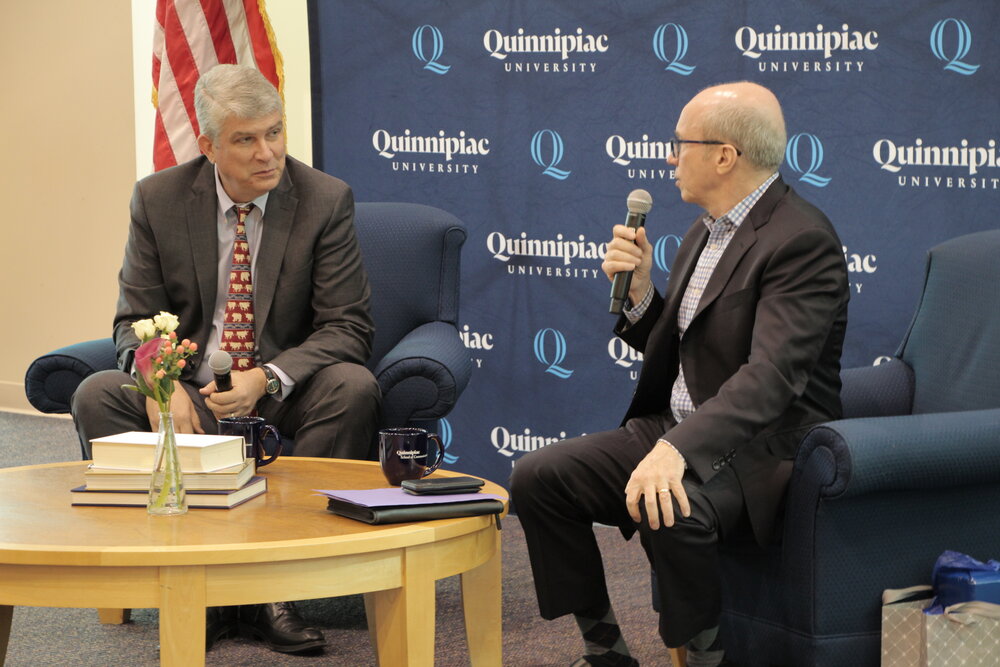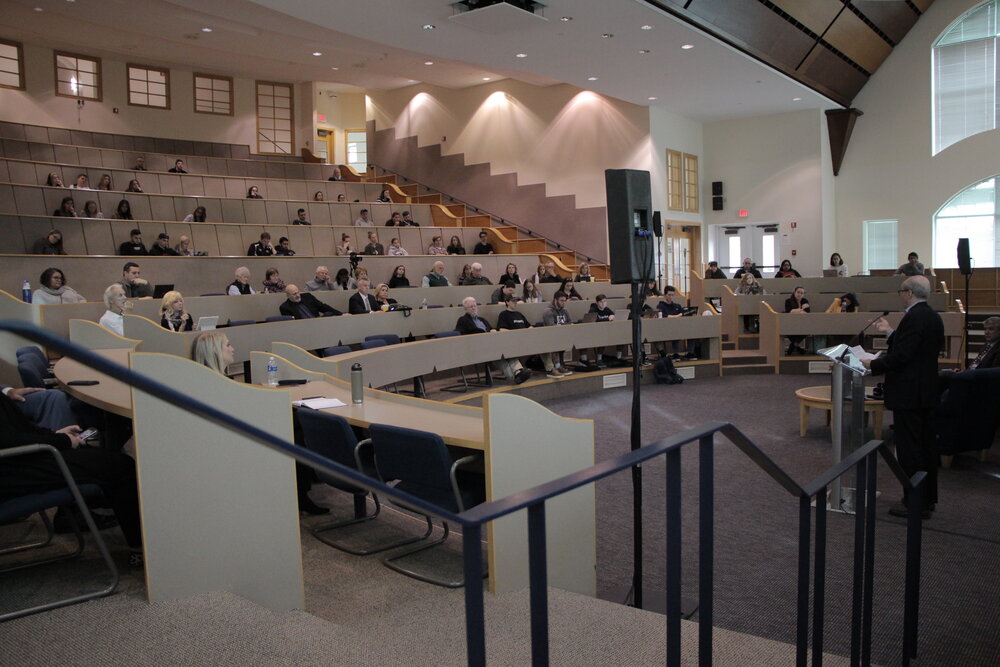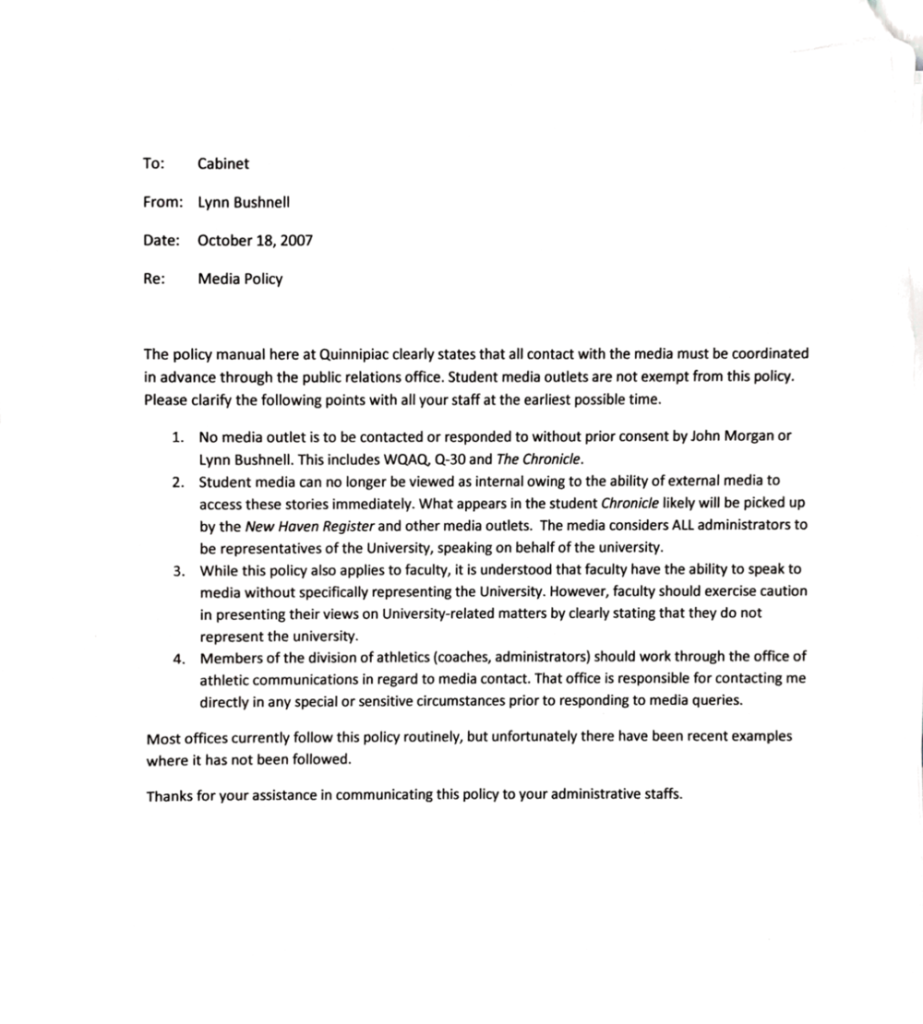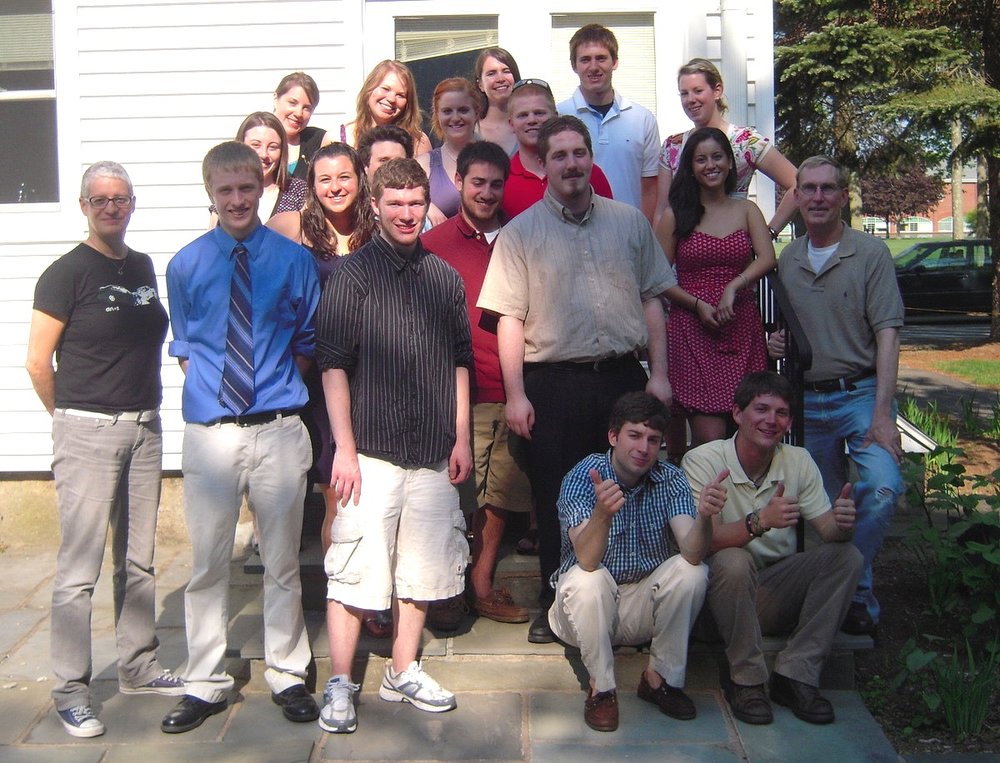
Fortune CEO Alan Murray spoke at Quinnipiac University’s Mount Carmel Auditorium about the future of journalism, and how Fortune Magazine is raising its journalistic standards going forward.
Chief executive officer of Fortune, and journalist since the age of 9, Alan Murray, came to Quinnipiac University on Friday to discuss the future of journalism, the importance of facts in a functioning democracy and old ladies on Facebook.
“Look, I do believe that facts are the most important building blocks of a successful society,” said Murray, “The discovery of facts is the first step in our legal process, and an understanding of facts is critical to the democratic process. A common basis of factual knowledge is the key to our ability to work together in our communities, and in our nation.”
The event titled “The Death of Truth: The Future of Journalism in the 21st Century” began around 2 p.m. at The Center Communications and Engineering, in a three-quarters full Mount Carmel Auditorium, for a discussion between Murray and School of Communications Dean, Chris Roush.

Murray, who says he’s been a journalist since the age of nine, gave an introduction to the crowd expressing the need for facts in society “Unfortunately, we live in a time when facts are under attack in lots of different ways,” said Murray.
From the beginning, Murray expressed he wasn’t interested in talking about the president and politics, but what he calls the ‘disturbing’ trend of the devaluation of facts in America.
“Unfortunately, we live in a time when facts are under attack in lots of different ways,” said Murray, “Let me say right up front, this is not going to be about President Trump. Yes, he has a peculiar attitude towards facts, but I think the problem we have as a society predates the election, and will continue long after he’s gone.”

Roush, the dean of the School of Communications, lead the discussion with Murray and asked him what things Fortune Magazine is doing to address issues of accuracy. “I think understanding that the values have to change somewhat and that people need to know that Fortune Magazine, like People Magazine, is committed to being right, more than it is to being first.”
What is Fortune magazine doing to address this issue? What are the standards that Fortune has, and what are they doing to make sure its readers understand that this is a credible news organization?
There are a couple of ways to answer that question.
One is just that in the age of 24/7 news organizations, all of us, have had a shift in priorities, and we explicitly tell our reporters it’s more important that you be right, than you be first. Because somebody who doesn’t care about right is more likely to be first. And then that’s a change from the days of print newspapers when you have a 24/7 news cycle, and you had enough time to do the adequate checking to make sure what you’re putting out is accurate. Sometimes you’d be on deadline and there’d be a lot of pressure, but it’s not the pressure you have now where every minute is madness. I think understanding that the values have to change somewhat and that people need to know that Fortune Magazine, like People Magazine, is committed to being right, more than it is to being first.
The second thing is one of the things that’s happened in the move from print publications to online publications is that there’s been a desperate search for eyeballs, because eyeballs are the way you get more ad dollars. I think that’s had a negative effect on all of journalism because the kinds of things you do to get eyeballs aren’t necessarily the things you would do to ensure the quality of the coverage. Being first helps you get more eyeballs. The google algorithm will treat you better, if you’re first. Having a sharp edge point of view will always get you more eyeballs than giving the straight take on the story. I think the desperate chase for eyeballs has caused a deterioration in journalism, including at Fortune.
What we are doing, in the midst of right now, is changing our business model. We will, in January, put up a paywall, we’re going to focus more on premium journalism, we will depend more on those who read us to pay for the journalism we do. That’s a good thing in terms of our focus because we’re going to be focused on producing news of a quality people are willing to pay for. I’m not sure if it’s a good thing for democracy because the only people who are going to get that news are going to be the people that pay for it.
>
“That’s a good thing in terms of our focus because we’re going to be focused on producing news of a quality people are willing to pay for. I’m not sure if it’s a good thing for democracy because the only people who are going to get that news are going to be the people that pay for it.”
Tell the Audience a little bit about what’s been happening at Fortune the last couple years, you’ve had three owners in the last two years, is that correct? What does that mean for the magazine?
Its been pretty wild. I joined five years ago just as Time Inc., the magazine company, was being spun out of Time Warner. That actually at the end of the day was a good thing, because what Time Warner had done is said ‘You, Time Inc., will continue to publish magazines, but we will let CNN handle online.’ so Fortune until five years ago, didn’t have a website. The Fortune web presence was part of CNN Money, and they said ‘We’re going to let Warner Brothers be our video outlet. So you can’t do video, you can’t do online, all you can do is print magazines.’ Which is effectively a death sentence. So it was essential to get Time Inc. out of Time Warner. That happened five years ago.
That was about the time I joined Fortune. We spent a lot of time building up our online presence, and when I became chief content officer I really focused on that. One of the things that had happened is there were 24 magazines at Time Inc. They didn’t talk to each other, so there were days, in 2017, I think it was 2017, Adele was at a concert and revealed that she had been asked to perform the Super Bowl, and she said ‘no.’ which was a huge story. We thought ‘How could somebody say no to performing at a Super Bowl?’ and at Time Inc. there were eight different stories written by eight different publications, on that Saturday, largely identical stories. So we weren’t taking advantage, at all in the digital world, of the scale of publishing a bunch of different magazines.
There was another day that same year when two different websites, that were part of Time Inc., published an avocado banana nut bread recipe on the same day. Different recipes. They all had different technology platforms, and it was just crazy. So I spent a lot of time unifying the digital platforms of the 24 magazines, which helped get them a larger digital presence.
But then very shortly after I took the job, Time Inc. was up for sale. We spent a year in investment banking meetings talking to potential buyers of Time Inc., but most of them after closely looking at it said ‘Nah, this is a print magazine, see ya later!’ Finally at the end of that year, Meredith, which publishes Better Homes and Gardens, AllRecipes, and a number of service magazines largely aimed at women, purchased time Inc., and then very quickly said we’re not interested in Henry Luce’s most favored babies, the first publications of Time Magazine. Which were Time, Fortune, Money, and Sports Illustrated, so we’re gonna sell all those. Then we went back into the investment banking process for another year to sell Time, Fortune, Money, and Sports Illustrated.

Murray spoke to the crowd at Quinnipiac about the changing journalism landscape. He talked about how journalists face the constant threat of job loss, and media outlets tanking or being sold. He said “I don’t want to discourage anybody here, but if you can find any place in journalism that isn’t in the midst of constant disruption these days, applause to you. I think what happened among journalist was ‘Yeah, wow. Is this place even gonna be here in a year? But is any other place going to be here in a year?’ It’s no more disrupted than any other media organization.”
Fortune was ultimately bought in December. It’s a long story, I’ll finish up soon, I promise. Fortune was finally sold last December to a Thai billionaire by the name of Chatchaval Jiaravanon, who asked me to be the CEO, and we’ve spent the last eight to nine months carving ourselves out of the company we were in for 89 years, and setting ourselves up.
Big step towards independence on Monday. We moved into new offices.
Because of that uncertainty around Fortune and its future, how do you keep journalists from leaving to go to greener pastures and how do you attract journalists to work at the magazine?
I don’t want to discourage anybody here, but if you can find any place in journalism that isn’t in the midst of constant disruption these days, applause to you. I think what happened among journalist was ‘Yeah, wow. Is this place even gonna be here in a year? But is any other place going to be here in a year?’ It’s no more disrupted than any other media organization.
I mean, think about what we’ve been through in the last couple of years with the rise and the collapse of MIC, the millennial news organization, which a year before it collapsed was seen as the kind of answer that everybody should follow. I mean BuzzFeed has had its ups and downs. I think for those of you who want to go into journalism careers you need to have good seat belts because it’s not a smooth ride.
>
“I mean, think about what we’ve been through in the last couple of years with the rise and the collapse of MIC, the millennial news organization, which a year before it collapsed was seen as the kind of answer that everybody should follow. I mean BuzzFeed has had its ups and downs. I think for those of you who want to go into journalism careers you need to have good seat belts because it’s not a smooth ride. ”
How can I get my 79-year-old mother to stop reading Facebook for her news?
Yeah, I know what you’re saying. It’s really tough. I think you need to sit and have a conversation with her about the importance of facts and the importance of truth.
She doesn’t want facts she just wants to read what she wants to read.
If we’re going to survive as a society, I think we need to get beyond that, but I think your mother will probably be okay at this point, but the rest of us need to figure out a way to get beyond that.

Dean Roush sat down next to Murray to lead the discussion on the future of journalism. Roush amused the audience when he asked how he can stop his 79-year-old mother from reading her news on Facebook. “She doesn’t want facts she just wants to read what she wants to read,” said Roush.
Roush then opened the room for discussion,
Attendees picked Murray’s brain for approximately 30 minutes on everything from paywalls, to the possibility of there being one central organization everyone believes as factual,
Though Fortune is pursuing standards to improve its story’s truth and accuracy, some feel larger solutions are still out there blowing in the wind.
“People have certain beliefs, so anything that supports them, it makes them more comfortable,” said Don Everett, Milford, “I’m not sure what can be done about it. How do you reach people who are so involved in social media today?”
What Everett expressed relates to the issue Roush raised with his mother. No matter how much quality journalism is out there, they feel people will continue to go on social media and be surrounded by a bubble of information they find to be true.
Everett believes this creates problems.
“They don’t have time to even think about checking what they hear, they’re processing and going on to something else,” said Everett. “I’m not sure what can be done.”

People in the Mount Carmel auditorium sat as Murray gave an introduction highlighting everything from how he got started as a journalist at 9, and what he believes the solutions are to keeping journalism accurate and safe in the future.
Although Everett felt some questions were left unanswered, one audience member was impressed by Murray’s appearance.
“I didn’t expect him to be so capable of answering questions,” said William Dean, freshman journalism major, Quinnipiac. “He was very quick on his feet, and I appreciated his ability to answer questions thoroughly, and interestingly. He kept the audience engaged, and you don’t normally expect that from a CEO of a big company.”




